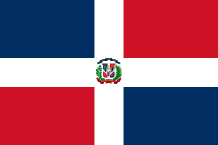DOMINICAN REPUBLIC
 The Dominican Republic is the eastern part of Hispaniola ; the western part is Haiti. The whole area is 48 717 sq km. The topography is very mountainous. Indeed, there are several ranges of mountains – Cordillera Oriental ; Cordillera Septentrional ; Sierra de Neyba and Sierra de Baoruco in the south-west ; Cordillera Central withs the Caribbean’s highest point, Pic Duarte (3175 m) – where grow ferns, bamboos, creepers, bromeliades or tall trees. The rivers are numerous.
The Dominican Republic is the eastern part of Hispaniola ; the western part is Haiti. The whole area is 48 717 sq km. The topography is very mountainous. Indeed, there are several ranges of mountains – Cordillera Oriental ; Cordillera Septentrional ; Sierra de Neyba and Sierra de Baoruco in the south-west ; Cordillera Central withs the Caribbean’s highest point, Pic Duarte (3175 m) – where grow ferns, bamboos, creepers, bromeliades or tall trees. The rivers are numerous.
Lago Enriquillo in the south-west is known because it is located at 40m below sea level. There are many coastal plains and fertiles valleys where are concentrated 60 % of the inhabitants. Over 250 species of bird (like Hispaniola’s Parrot, woodpecker, palm chat, maroon pelican, blue heron, American frigate) nest in the island ; some of them are endemic. Many marine mammals (whales, manatees) and also rays, turtles frequent the coral reefs. There are a lot of reptiles and the most curious is the Jaragua lizard, discovered in 1998 ; with its 25mm, it is the world’s smallest terrestrial vertebrate.
To protect the environment, many parks and reserves have been founded all over the territory. The country has almost 1000 miles of coast where are located the mangrove and beautiful beaches, in the south-east.
The island exports sugar, rum, coffee, cocoa, tabacco, nickel and few gold. Around 40 of free zones and tourism aim to stimulate the economy.
Hispaniola was discovered in 1492 by Christopher Columbus. It was colonized by the Spanish but 400 000 Indian Tainos already lived in this land. Thirty years later, there were exterminated by the Europeans. The Dominican Republic was the New World’s first territory where were built : the first fort (Fortaleza Ozama, commenced in 1502) ; the first monastery (Monasterio de San Francisco, dated from 1508) ; the first hospital (Hospital San Nicolás de Barí, built in 1503, now in ruins) ; the first convent of the Dominicans (Convento de la Orden de los Predicadores, built in 1510) ; the oldest cathedral in operation in the Americas (Catedral Primada de América, the foundation stone was laid in 1514 by Diego Columbus).
All these buildings were constructed thanks to the island’s wealth based on the mining resources and the labour of the Taino slaves then the African slaves.
When the Spanish gold digger had exhausted the mines, they abandoned the island. The French settled in the western part that they named Saint-Domingue, in 1697. The Treaty of Ryswick shared the island. In 1795, France received the Spanish part during the Treaty of Bale’s signature. From 1802 to 1808, the French troops occupied this eastern part after their defeat by the St Domingue’s rebels ; this colony became the Republic of Haiti. In 1808, the French army was expeled and, in 1814, Spain appropriated again its colony but the colonists proclaimed the independence of the Dominican Republic, in 1821. Next year, the Haitians invaded the Dominican Republic. On February 27, 1844, Juan Pablo Duarte regarded as the « Father of the Country » led a rebellion to get the Dominican Republic’s independence and chased out the Haitians. The Dominicans were in debt to the Americans who invaded the island in 1916 and stayed there until 1924.
In 1965, the USA came back in the island to stop the Civil War that ended in 1973.
Dominican Republic is led by a President democratically elected by the people.
Area : 48 717 sq km (18,8 sq miles)
Population : 10 million inhabitants
Capital : Santo Domingo (de Guzmán)
Language : Spanish
Currency : Dominican Republic Peso (RD$)
People : Dominicans
